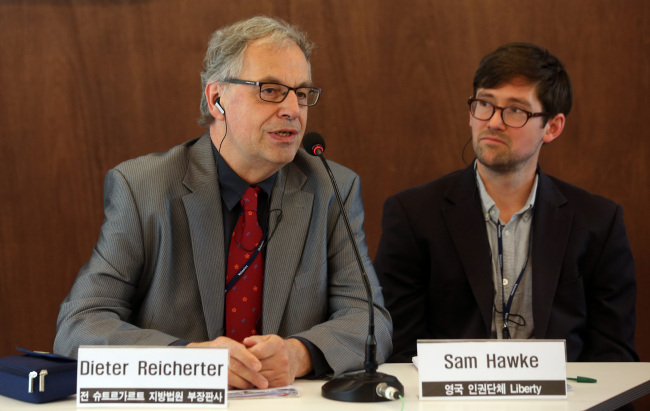Foreign and local experts from human rights organizations and academia addressed on Tuesday the danger of the use of water cannons by South Korean police at street rallies and called for better protection of human rights in keeping the public order.
An association of human rights organizations investigating the use of police force in last year’s antigovernment rallies held a symposium in Seoul, bringing together a former German judge, a British campaigner and Korean activists and scholars.
The event kicked off with a video showing Korean farmer Baek Nam-gi being knocked down by a water cannon blast last November at an antigovernment protest that spiraled into violence. In the video, the water cannon was directly aimed at Baek, even after he had collapsed, with those surrounding him urgently shouting for help.
Baek Do-ra-ji, the daughter of the farmer who remains unconscious, criticized what she saw as the government’s violent oppression of protests and its inaction to bring justice for her father.
“In a democratic country, it is not possible to hold an illegal rally. All the rallies are legal (based on the constitutional freedom of speech),” she said. “More than half of my father’s brain was severely damaged, so doctors said that it would be hard to expect him to regain consciousness. His condition is getting worse day by day.”
“But our family has never received any apology from the government,” she said. “We have filed complaints against seven police officials (involved in the use of water cannons during the protest), but nothing is being done,” she added, arguing that her father’s injury is a criminal case. The prosecution is currently investigating the case.
Dieter Reicherter, a former judge at the regional court of Stuttgart, cited a similar case in Germany -- the 2010 protest in Stuttgart against the large-scale redevelopment project known as Stuttgart 21.
“The police used batons, capsaicin and water cannons, which resulted in several serious injuries,” Reicherter said, referring to Deitrich Wagner, a German who lost his eyesight after being struck in the face.
“This was a very traumatic experience for many of them as well as for many adults, leading them to lose their confidence in a democratic country governed by the rule of law.”
“Only public pressure and engagement of lawyers criticizing the state violence in the rally brought the result years later,” he said, citing the German court’s ruling in favor of the protestors who sustained injuries in the crackdown.
Three of the German police officers were found guilty of negligence in the verdict in which the court said that “interventions like these place the strongest possible restrictions on freedom of assembly,” and that “it is questionable whether use of the water jets was appropriate.”
Sam Hawke, a policy assistant at a Britain-based civil rights advocacy group Liberty, shared how his organization successfully blocked the U.K. government’s attempt to introduce water cannons in 2015.
“By the time of the 2011 riots, the U.K. police already appeared to be adopting more confrontational, even militarized methods of protest policing,” Hawke said. “In 2010, for example, officers clad in full riot-gear kettled (contained) large numbers of student protestors indiscriminately for several hours.”
The British Home Affairs Ministry refused to allow the use of water cannon in England and Wales in 2015 amid opposition from the public, saying that the tool has the capacity to cause harm without safeguards. The rejection came after then-London Mayor Boris Johnson authorized the purchase of three second-hand cannons in 2014 to be used in the event of a serious public disorder.
“If police use indiscriminate weapons which imply every protestor is a potential enemy, the police will likely treat them as such. While some protestors are likely to flee in the face of water cannons, others will anticipate its use and take on an aggressive posture as a means of defense,” Hawke said. “A vicious cycle begins, since the police’s likely response is to heighten intimidation as a further defensive measure.”
Hawke stressed the importance of “proportionate policing” and building trust between protestors and police, given the water cannon’s capacity for brutality and its indiscriminate nature.
“The effective protest policing is best achieved through forward planning, effective communication and the timely deployment of officers to use lawful powers in a proportionate way,” he said. “Above all, police must facilitate, not prevent, protests.”
Lee Ho-joong, a law professor at Sogang University Law School, noted that it is impossible to distinguish those committing violence from peaceful protestors when police use water jets to break up rallies.
“Given that, the use of water cannons at the protest scene is impossible to be used proportionately in the first place. The international law does not directly ban the use of water cannons, but it can be reasonably said that water cannons should be forbidden from use.”
Earlier in the day, South Korean police announced a measure to install additional monitors within water cannons to better oversee how they are used on protestors to prevent injuries. They added that the resolution of the monitors will also be improved.
Police did not apologize for the Baek Nam-ki incident, maintaining that it was necessary to deploy water cannons to stop “violent” protests and keep public order.
According to the symposium organizers, police were invited to attend to give their stance, but they refused the call, citing the ongoing investigation into Baek’s case.
By Ock Hyun-ju (
laeticia.ock@heraldcorp.com)








